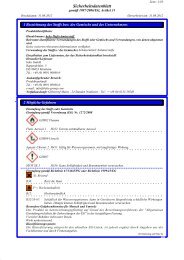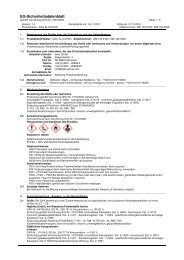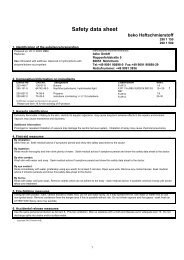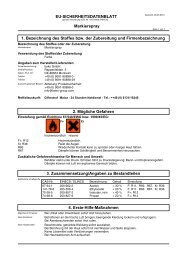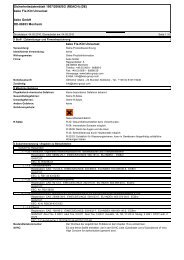Safety Data Sheet - beko GmbH
Safety Data Sheet - beko GmbH
Safety Data Sheet - beko GmbH
Create successful ePaper yourself
Turn your PDF publications into a flip-book with our unique Google optimized e-Paper software.
DR<br />
<strong>Safety</strong> <strong>Data</strong> <strong>Sheet</strong><br />
according to 1907/2006/EC, Article 31<br />
Page 1/6<br />
Printing date 12.01.2009 Revision: 12.01.2009<br />
* 1 Identification of substance:<br />
· Product details:<br />
· Trade name: <strong>beko</strong> Tackcon Primer<br />
· Article number: 240 310 250<br />
· Application of the substance / the preparation : Primer for adhesive or sealant<br />
· Manufacturer/Supplier:<br />
<strong>beko</strong> <strong>GmbH</strong><br />
Rappenfeldstr. 5<br />
DE-86653 Monheim<br />
Phone: +49 (0) 9091 90898-0<br />
Fax +49 (0) 9091 90898-29<br />
e-mail: info@<strong>beko</strong>-group.com<br />
Internet: www.<strong>beko</strong>-group.com<br />
· Information department: Laboratory<br />
Phone: +49 (0) 9091 90898-0<br />
· Emergency information: +49 (0) 9091 3836<br />
* 2 Hazards identification<br />
· Hazard description:<br />
Xi Irritant<br />
F Highly flammable<br />
· Information pertaining to particular dangers for man and environment<br />
R 36 Irritating to eyes.<br />
R 43 May cause sensitisation by skin contact.<br />
R 66 Repeated exposure may cause skin dryness or cracking.<br />
R 67 Vapours may cause drowsiness and dizziness.<br />
Contains isocyanates. See information supplied by the manufacturer.<br />
· Classification system<br />
The classification was made according to the latest editions of the EU-lists, and expanded upon<br />
from company and literature data.<br />
* 3 Composition/information on ingredients<br />
· Chemical characterization<br />
· Description: Mixture of polyisocyanates in organic solution<br />
· Dangerous components:<br />
CAS: 78-93-3<br />
EINECS: 201-159-0<br />
methylethylketone Xi, F; R 11-36-66-67 40-60%<br />
CAS: 123-86-4<br />
EINECS: 204-658-1<br />
n-butyl acetate R 10-66-67 10-25%<br />
CAS: 63368-95-6 aromatic-aliphatic polyisocyanate Xi; R 43 5-15%<br />
CAS: 28182-81-2 aliphatic polyisocyanate Xi; R 43-52/53 2.5-10%<br />
CAS: 1333-86-4<br />
EINECS: 215-609-9<br />
Carbon black 2.5-10%<br />
CAS: 108-65-6<br />
EINECS: 203-603-9<br />
2-methoxy-1-methylethyl acetate Xi; R 10-36 < 2.5%<br />
· Additional information : For the wording of the listed risk phrases refer to section 16.<br />
GB<br />
(Contd. on page 2)
DR<br />
<strong>Safety</strong> <strong>Data</strong> <strong>Sheet</strong><br />
according to 1907/2006/EC, Article 31<br />
Page 2/6<br />
Printing date 12.01.2009 Revision: 12.01.2009<br />
Trade name: <strong>beko</strong> Tackcon Primer<br />
4 First aid measures<br />
(Contd. of page 1)<br />
· General information Immediately remove any clothing soiled by the product.<br />
· After inhalation<br />
Supply fresh air. If required, provide artificial respiration. Keep patient warm. Consult doctor if<br />
symptoms persist.<br />
In case of unconsciousness, place patient stably in side position for transportation.<br />
· After skin contact Immediately wash with water and soap and rinse thoroughly.<br />
· After eye contact<br />
Rinse opened eye for several minutes under running water. Then consult a doctor.<br />
· After swallowing Do not induce vomiting; call for medical help immediately.<br />
· The following symptoms may occur:<br />
Headache<br />
Dizziness<br />
Gastric or intestinal disorders.<br />
Drowsiness<br />
Breathing difficulty<br />
5 Fire fighting measures<br />
· Suitable extinguishing agents CO2, extinguishing powder or water spray.<br />
· For safety reasons unsuitable extinguishing agents Water with full jet.<br />
· Special hazards caused by the material, its products of combustion or resulting gases:<br />
In case of fire, the following can be released:<br />
Carbon monoxide (CO)<br />
Hydrogen chloride (HCl)<br />
Nitrogen oxides (NOx)<br />
In certain fire conditions, traces of other toxic gases cannot be excluded.<br />
Hydrogen cyanide (HCN)<br />
Isocyanates<br />
· Protective equipment: Mount respiratory protective device.<br />
6 Accidental release measures<br />
· Person-related safety precautions:<br />
Ensure adequate ventilation.<br />
Use respiratory protective device against the effects of fumes/dust/aerosol.<br />
Keep away from ignition sources.<br />
· Measures for environmental protection: Do not allow to enter sewers/ surface or ground water.<br />
· Measures for cleaning/collecting:<br />
Absorb with liquid-binding material (sand, diatomite, acid binders, universal binders, sawdust).<br />
Dispose contaminated material as waste according to item 13.<br />
Send for recovery or disposal in suitable receptacles.<br />
Do not close them (reaction with water forming carbon dioxide).<br />
7 Handling and storage<br />
· Handling<br />
· Information for safe handling:<br />
Open and handle receptacle with care<br />
Ensure good interior ventilation, especially at floor level. (Fumes are heavier than air).<br />
· Information about protection against explosions and fires:<br />
Keep ignition sources away - Do not smoke.<br />
Protect against electrostatic charges.<br />
(Contd. on page 3)<br />
GB
DR<br />
<strong>Safety</strong> <strong>Data</strong> <strong>Sheet</strong><br />
according to 1907/2006/EC, Article 31<br />
Page 3/6<br />
Printing date 12.01.2009 Revision: 12.01.2009<br />
Trade name: <strong>beko</strong> Tackcon Primer<br />
· Storage<br />
· Requirements to be met by storerooms and receptacles:<br />
Store in a cool location.<br />
Prevent any seepage into the ground.<br />
· Information about storage in one common storage facility: Not required.<br />
· Further information about storage conditions: Keep receptacle tightly sealed.<br />
8 Exposure controls and personal protection<br />
· Additional information about design of technical systems: No further data; see item 7.<br />
· Components with limit values that require monitoring at the workplace:<br />
78-93-3 methylethylketone<br />
WEL Short-term value: 899 mg/m³, 300 ppm<br />
Long-term value: 600 mg/m³, 200 ppm<br />
Sk<br />
123-86-4 n-butyl acetate<br />
WEL Short-term value: 966 mg/m³, 200 ppm<br />
Long-term value: 724 mg/m³, 150 ppm<br />
1333-86-4 Carbon black<br />
WEL Short-term value: 7 mg/m³<br />
Long-term value: 3.5 mg/m³<br />
108-65-6 2-methoxy-1-methylethyl acetate<br />
WEL Short-term value: 548 mg/m³, 100 ppm<br />
Long-term value: 274 mg/m³, 50 ppm<br />
Sk<br />
· Additional information: The lists that were valid during the creation were used as basis.<br />
(Contd. of page 2)<br />
· Personal protective equipment<br />
· General protective and hygienic measures<br />
Avoid contact with the eyes and skin.<br />
Immediately remove all soiled and contaminated clothing.<br />
Wash hands before breaks and at the end of work.<br />
Do not eat, drink, smoke while working.<br />
· Breathing equipment:<br />
In case of brief exposure or low pollution use respiratory filter device. In case of intensive or longer<br />
exposure use respiratory protective device that is independent of circulating air.<br />
Short term filter device:<br />
Filter A<br />
· Protection of hands:<br />
PVA gloves of superior quality.<br />
The selection of the suitable gloves does not only depend on the material, but also on further marks<br />
of quality and varies from manufacturer to manufacturer. As the product is a preparation of several<br />
substances, the resistance of the glove material can not be calculated in advance and has therefore<br />
to be checked prior to the application.<br />
· Eye protection: Tightly sealed goggles.<br />
· Body protection: Protective work clothing.<br />
9 Physical and chemical properties:<br />
· General Information<br />
Form: Fluid<br />
Colour: Black<br />
Odour: Pungent<br />
(Contd. on page 4)<br />
GB
DR<br />
<strong>Safety</strong> <strong>Data</strong> <strong>Sheet</strong><br />
according to 1907/2006/EC, Article 31<br />
Page 4/6<br />
Printing date 12.01.2009 Revision: 12.01.2009<br />
Trade name: <strong>beko</strong> Tackcon Primer<br />
· Change in condition<br />
Melting point/Melting range: undetermined<br />
Boiling point/Boiling range: 79°C<br />
· Flash point: -8°C<br />
· Self-ignition temperature: > 200°C<br />
· Self igniting: Product is not selfigniting at room temperature.<br />
(Contd. of page 3)<br />
· Danger of explosion: Product is not explosive. However, formation of explosive air/<br />
vapour mixtures are possible.<br />
· Explosion limits:<br />
Lower: 1.8 Vol %<br />
Upper: 11.5 Vol %<br />
· Density at 20°C: 0.92<br />
· Solubility in / Miscibility with<br />
Water: Partly miscible<br />
· Viscosity:<br />
dynamic at 20°C: 50 mPa.s<br />
· Solvent content:<br />
· Solids content: 30 %<br />
10 Stability and reactivity<br />
· Thermal decomposition / conditions to be avoided:<br />
No decomposition if used according to specifications.<br />
· Materials to be avoided:<br />
· Dangerous reactions:<br />
Reacts with alcohols, amines, aqueous acids and alkalis.<br />
Reacts with water forming carbon dioxide.Danger of receptacles bursting because of vapour<br />
overpressure.<br />
Reacts with strong oxidizing agents.<br />
· Dangerous products of decomposition: No dangerous decomposition products known.<br />
11 Toxicological information<br />
· Acute toxicity:<br />
· LD/LC50 values that are relevant for classification:<br />
78-93-3 methylethylketone<br />
Oral LD50 3300 mg/kg (rat)<br />
Dermal LD50 5000 mg/kg (rbt)<br />
123-86-4 n-butyl acetate<br />
Oral LD50 14000 mg/kg (rat)<br />
Inhalative LC50/4 h >21.0 mg/l (rat)<br />
· Primary irritant effect:<br />
· on the skin:<br />
Frequent or prolonged contact may irritate and cause dermatitis.<br />
Irritant to skin and mucous membranes.<br />
· on the eye: Irritating effect.<br />
· Sensitization: Sensitization possible through skin contact.<br />
(Contd. on page 5)<br />
GB
DR<br />
<strong>Safety</strong> <strong>Data</strong> <strong>Sheet</strong><br />
according to 1907/2006/EC, Article 31<br />
Page 5/6<br />
Printing date 12.01.2009 Revision: 12.01.2009<br />
Trade name: <strong>beko</strong> Tackcon Primer<br />
· Sensitisation May cause sensitisation by skin contact.<br />
12 Ecological information:<br />
· Ecotoxical effects:<br />
· Other information: -<br />
· General notes:<br />
Water hazard class 1 (German Regulation) (Self-assessment): slightly hazardous for water.<br />
Do not allow product to reach ground water, water course or sewage system.<br />
13 Disposal considerations<br />
· Product:<br />
· Recommendation<br />
Must be disposed of in an incinerator for hazardous waste according to official regulations.<br />
· Waste disposal key: 14 06 03*<br />
· Uncleaned packagings:<br />
· Recommendation: Disposal must be made according to official regulations.<br />
14 Transport information<br />
· Land transport ADR/RID (cross-border)<br />
(Contd. of page 4)<br />
· ADR/RID class: 3 Flammable liquids.<br />
· Danger code (Kemler): 339<br />
· UN-Number: 1866<br />
· Packaging group: II<br />
· Label 3<br />
· Description of goods: 1866 RESIN SOLUTION (vapor pressure at 50°C at most 110 kPa)<br />
· Maritime transport IMDG:<br />
· IMDG Class: 3<br />
· UN Number: 1866<br />
· Label 3<br />
· Packaging group: II<br />
· EMS Number: F-E,S-E<br />
· Marine pollutant: No<br />
· Propper shipping name: RESIN SOLUTION<br />
· Air transport ICAO-TI and IATA-DGR:<br />
· ICAO/IATA Class: 3<br />
· UN/ID Number: 1866<br />
· Label 3<br />
(Contd. on page 6)<br />
GB
DR<br />
<strong>Safety</strong> <strong>Data</strong> <strong>Sheet</strong><br />
according to 1907/2006/EC, Article 31<br />
Page 6/6<br />
Printing date 12.01.2009 Revision: 12.01.2009<br />
Trade name: <strong>beko</strong> Tackcon Primer<br />
· Packaging group: II<br />
· Propper shipping name: RESIN SOLUTION<br />
* 15 Regulations<br />
· Markings according to EU guidelines:<br />
The product has been classified and marked in accordance with EU directives.<br />
· Code letter and hazard designation of product:<br />
Xi Irritant<br />
F Highly flammable<br />
· Hazard-determining components of labelling:<br />
aromatic-aliphatic polyisocyanate<br />
aliphatic polyisocyanate<br />
· Risk phrases:<br />
36 Irritating to eyes.<br />
43 May cause sensitisation by skin contact.<br />
66 Repeated exposure may cause skin dryness or cracking.<br />
67 Vapours may cause drowsiness and dizziness.<br />
· <strong>Safety</strong> phrases:<br />
7/9 Keep container tightly closed and in a well-ventilated place.<br />
16 Keep away from sources of ignition - No smoking.<br />
24 Avoid contact with skin.<br />
37 Wear suitable gloves.<br />
· <strong>Safety</strong> phrases in case of sale to the general public :<br />
2 Keep out of the reach of children.<br />
46 If swallowed, seek medical advice immediately and show this container or label.<br />
(Contd. of page 5)<br />
· Special labelling of certain preparations:<br />
Contains isocyanates. See information supplied by the manufacturer.<br />
· Advised phrases:<br />
S 26 In case of contact with eyes, rinse immediately with plenty of water and seek medical advice.<br />
* 16 Other information:<br />
This information is based on our present knowledge. However, this shall not constitute a guarantee<br />
for any specific product features and shall not establish a legally valid contractual relationship.<br />
This data sheet is particularly in accordance with the european directives 1999/45/EC and 2001/59/<br />
EC ; it is written according to the european regulation 1907/2006/EC (annex II).<br />
· Relevant R-phrases<br />
10 Flammable.<br />
11 Highly flammable.<br />
36 Irritating to eyes.<br />
43 May cause sensitisation by skin contact.<br />
52/53 Harmful to aquatic organisms, may cause long-term adverse effects in the aquatic<br />
environment.<br />
66 Repeated exposure may cause skin dryness or cracking.<br />
67 Vapours may cause drowsiness and dizziness.<br />
· Department issuing MSDS: Laboratory<br />
· In accordance with the international standard :<br />
ISO 11014-1<br />
An asterisk in the margin of a paragraph means amendments in comparison to the former version.<br />
GB



